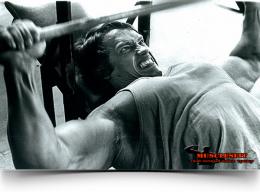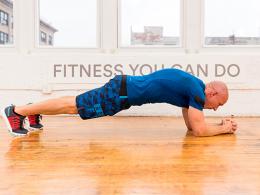How to do bench press properly. The Complete Guide to Mastering Proper Technique
Dr. Lane Norton is a very competent person in his field, and he also has extraordinary strength! Follow his advice and examples on proper bench press technique.
The bench press is one of the most important upper body exercises, especially for the chest muscles. It not only plays a big role in the development of muscles, but is also extremely important for increasing strength. Many people think that the bench press is only a shoulder and chest exercise, but I will tell you that it works not only the triceps, shoulders and back, but even the buttocks. This complex exercise can be detrimental if done incorrectly.
If you have been doing the bench press up to now and have not thought about the correct execution, then the time has come to stop and think about improving the technique. 7 years ago, I tore my right chest muscle while doing the wrong bench press. And I'll tell you straight - it was wildly unpleasant.
Since then, I have spent many years learning how and which muscle groups to include in this exercise. By learning how to improve my technique, I not only learned how to do it safely, but also improved my performance.
So if you really ready to get bigger and stronger, watch this video. In it, I detail what I've learned from the likes of Ben Esgro, Dr. Mike Zordos, and USAP World Team CEO Matt Gary, so you too can become a pro like them!
How to Bench Press Properly - Everything You Need to Know
1 Equipment
Although you don't really need anything other than your own body, there are some pieces of equipment that will make this exercise safer and more efficient.
Wrist bandages
The most important piece of equipment I use is the wrist wraps. To lift the maximum weight, you need to apply the maximum possible effort. To do this, you need to keep your wrist vertical. Wrist wraps will help keep your wrist in a straight line, which is why I always recommend using them.
The bandage should completely wrap around the wrist joint, so it should be long enough to wrap around the wrist just below and above the joint. I prefer bandages 45-61 cm long. This is enough to wrap your wrist properly. However, you can use bandages with a length of 30-90 cm.
The degree of compression is an important criterion here. In general, tighten the bandage so tight that there is no pain or numbness. This will provide support to the wrists when lifting heavy weights.
Shoes
Your legs are your mainstay, so what you put on them is very important - yes, even when doing the bench press! As a rule, the choice of shoes comes down to personal preference, but you need shoes that will provide reliable traction on the floor during the exercise.
I prefer to use weightlifting shoes (weightlifters) because they have a high heel, which allows better grip on the floor. It also has an anti-slip sole. Some, however, prefer flat-soled shoes such as wrestling shoes (wrestling shoes) or converse. Whatever your choice of shoe, it should provide stability when doing the bench press.
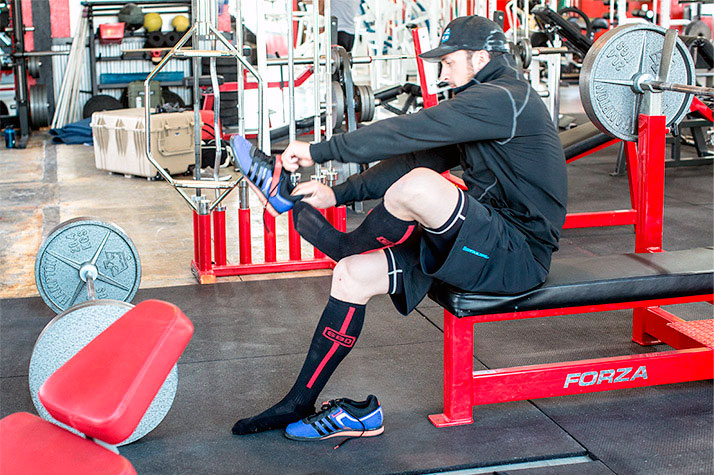
“Whatever your choice of shoe, it should provide stability for the bench press.”
Chalk
I apply chalk to my shoulders and upper back where it meets the bench to prevent slipping and create a secure body position.
Chalk is optional, but if you're going to lift a lot of weight, have someone apply it to your upper back. You may even notice a difference in performance and body stability.
2 Starting position
Now let's talk directly about the execution technique and find out how to do the bench press while lying on a horizontal bench. The effectiveness of the exercise depends on the position of the body under the bar, as well as how much weight you can squeeze out. Don't take this lightly. Follow the following tips to lift maximum weight safely!
Foot position for bench press
Although the position of the feet in the bench press is not as important as in the deadlift or squat, nevertheless, this topic is worth touching. Correct positioning of the legs will be a source of strength for the exercise.
Try to take your legs back (in the direction of the buttocks) as far as you can, while the feet should be in contact with the floor with the entire surface. Depending on your height and build, this position may vary. The main thing is that the legs are fixed securely, so that through the support you can transfer the maximum force to the whole body.
Back position
As in the case of the feet, the position of the back can vary depending on the features of the body structure. In fact, you need to lie under the bar so that it is convenient to remove the barbell from the racks, and the power rack stops do not interfere when you press the barbell up. Pulling your shoulder blades together will prepare you for the exercise and also protect your shoulders. Imagine that you are trying to crush a grape between your shoulder blades and then press your upper back into the bench.
back arch
This is a controversial topic, especially among bodybuilders. Many of them think that back arching is only for powerlifting, but in fact, arching your lower back keeps your spine in a neutral position and your back in tension, which helps protect it during the exercise.
If you are not a powerlifter, then the back arch should not be too strong. However, a slight arch in the lower back should always be present. If you are a powerlifter, then arch your back as far as you can. This will shorten the lift distance.
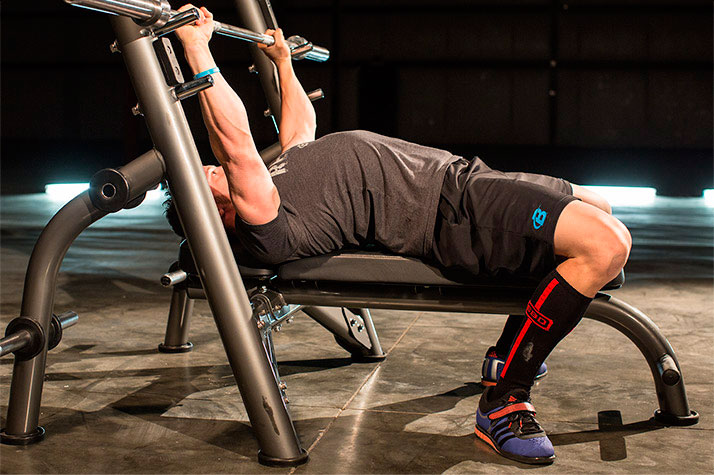
"A slight arch in the lower back should always be present."
grip
Grab the bar firmly, with effort. Keep it as close to the base of your palm as possible. If the bar is closer to the fingers, the wrist will bend back. The straight position of the wrist will allow you to make the most effort.
The width of the grip depends on the characteristics of the physique. The longer your arms are, the wider your grip should be, and vice versa. However, I am not a fan of too wide or too narrow grips. Many take the bar around the notches or inside them. I don't recommend using a fake grip, it can be dangerous. Therefore, place your thumbs in a closed grip.

"The width of the grip depends on the characteristics of the physique."
Breath
Take a deep breath, take the bar off the racks, and then exhale. Take another deep breath before lowering the weight. Hold your breath and tighten your abdominal muscles. Hold your breath until you have passed the peak effort of the exercise, and then exhale forcefully.
Removing the neck from the stands
Don't waste energy taking the bar off the racks, especially when you're lifting heavy weights. If you don't have a belay partner to help, push your back into the bench just enough so that the bar can come off the racks.
3 How to do a bench press - exercise technique
Once you've taken a deep breath and tightened up, start lowering the bar. Imagine at this moment that you are trying to bend it into the letter "U". This will help bring your elbows closer to your body, engage your lats, and protect your shoulders.
Where the bar touches the body depends on the length of your arms and the width of your grip. In any case, at this point in the exercise, the forearm should be at a 90 degree angle to the floor. If the angle is larger or smaller, you may lose strength.
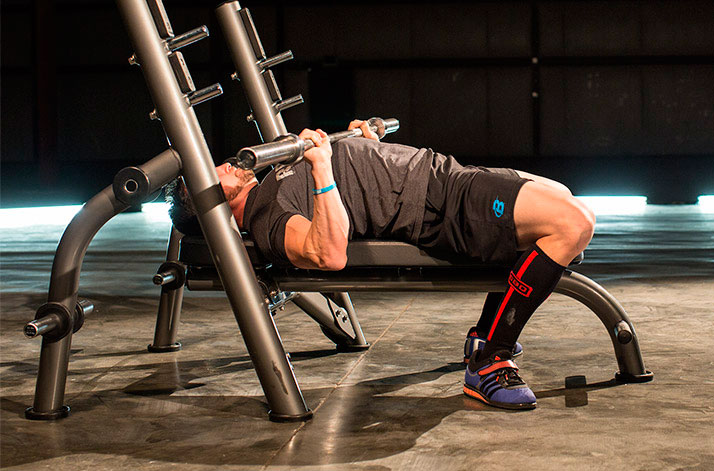
"At the bottom of the exercise, the forearm should be at a 90-degree angle to the floor."
If you have long arms and you use a close grip, the bar will drop down your body. If the arms are short and the grip is wide, the bar will touch the upper chest. Most people touch the bar in the area from the upper abdomen to the line of the nipples. Whatever point the bar touches the body, try not to change it with each repetition.
When the bar touches the body, begin to squeeze the weight, while tensing the muscles of the buttocks and pushing the legs into the floor. No, this is not a joke. Thus, you can maximize the tension and squeeze more weight.
At this point, imagine that you are pushing the bar away from you. When lifted, the bar should describe a small arc in the form of an inverted "J".
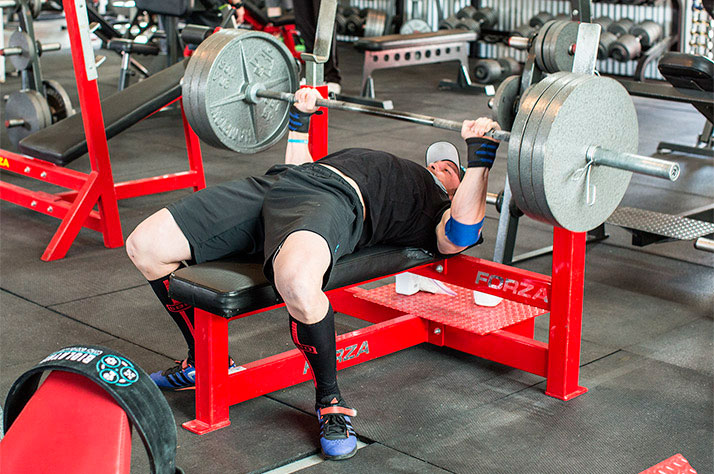
“Push your feet into the floor. This way you can push yourself to the maximum and squeeze more weight.”
4 Common Mistakes When Doing the Bench Press
As you can see, doing the bench press is more difficult than it might seem at first glance. The most common mistake when doing it is that some make the neck literally bounce off the chest when lifting. This is a very dubious method, not only because it creates a lot of pressure on the chest, but also makes it impossible to keep the muscles in tension. Also, if the bar bounces off your chest, how can you claim to have lifted it?
Many do not breathe properly and do not tense the press enough, so pay special attention to these points. You will be surprised how much more weight you can lift if you tighten your abdominal muscles and take deep breaths.
Also, I often see some people turn their elbows out to the sides, believing that this will increase the involvement of the chest muscles. Even if this is the case, you should not do this, because it is dangerous. That's how I tore my chest muscle: my grip was too wide, and my elbows were outstretched. Elbows spread to the sides mean that the latissimus dorsi muscles are not included in the work and the exercise is performed with low efficiency.
I often see some lift their shoulders at the top of the exercise, spread their shoulder blades as they lift the weight, and also move their feet across the floor. Anything that forces you to relax your body and straighten your shoulder blades makes the exercise ineffective and dangerous. So watch your movements and stay in suspense.
Practice bench press!
Now you know how to bench press safely and effectively. It requires a certain skill, like squats or other compound exercises. The more you practice bench press, the better the result will be. Start with a light weight and increase as you get the hang of the technique.


